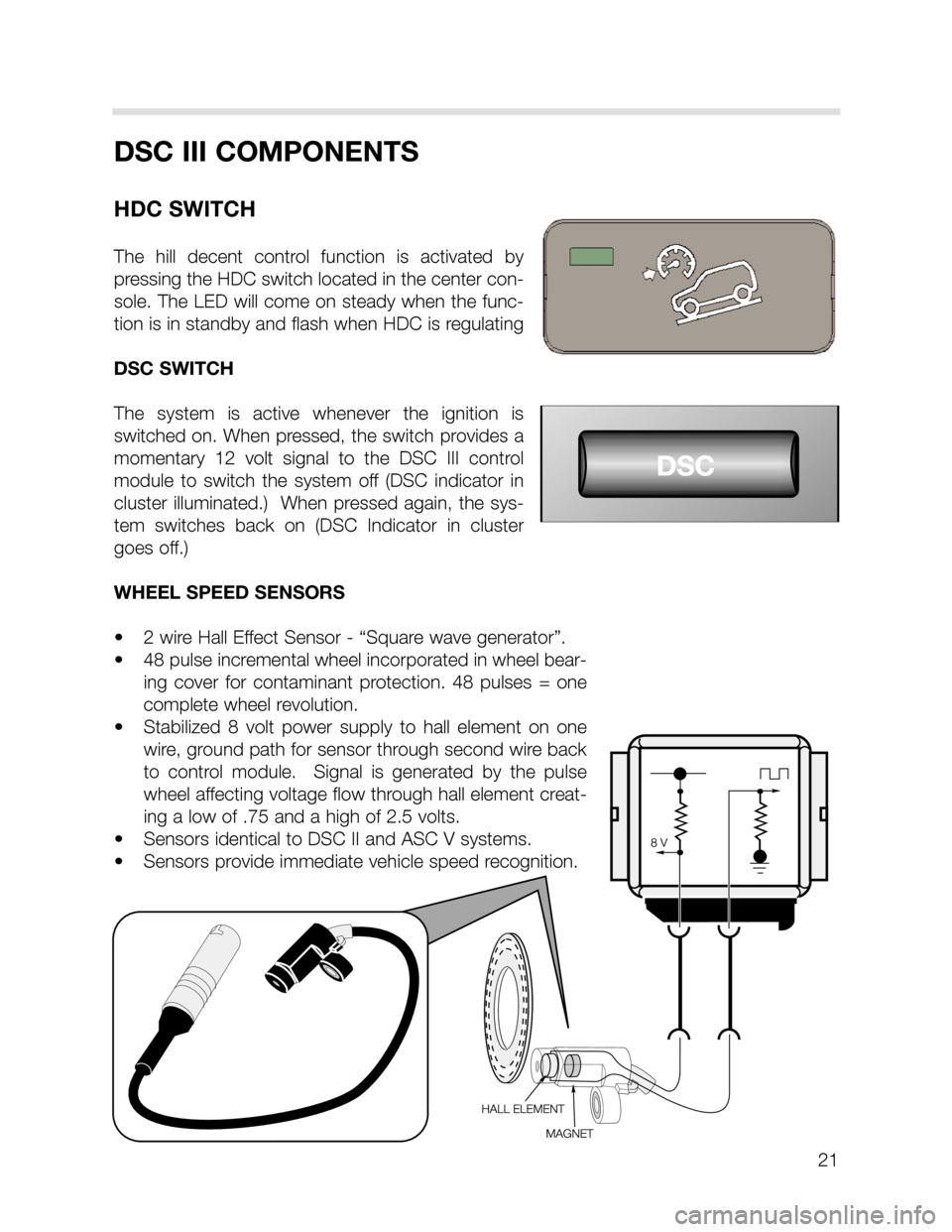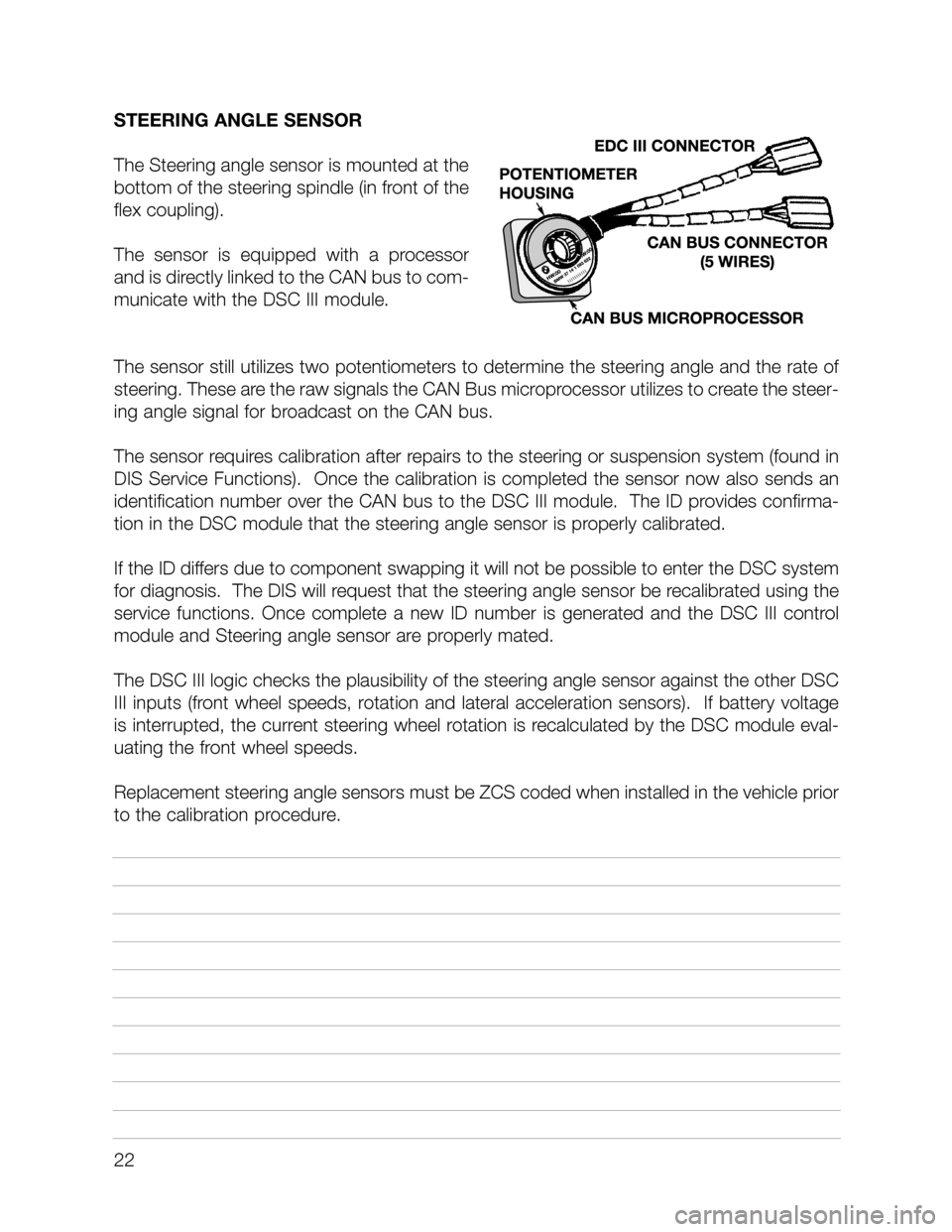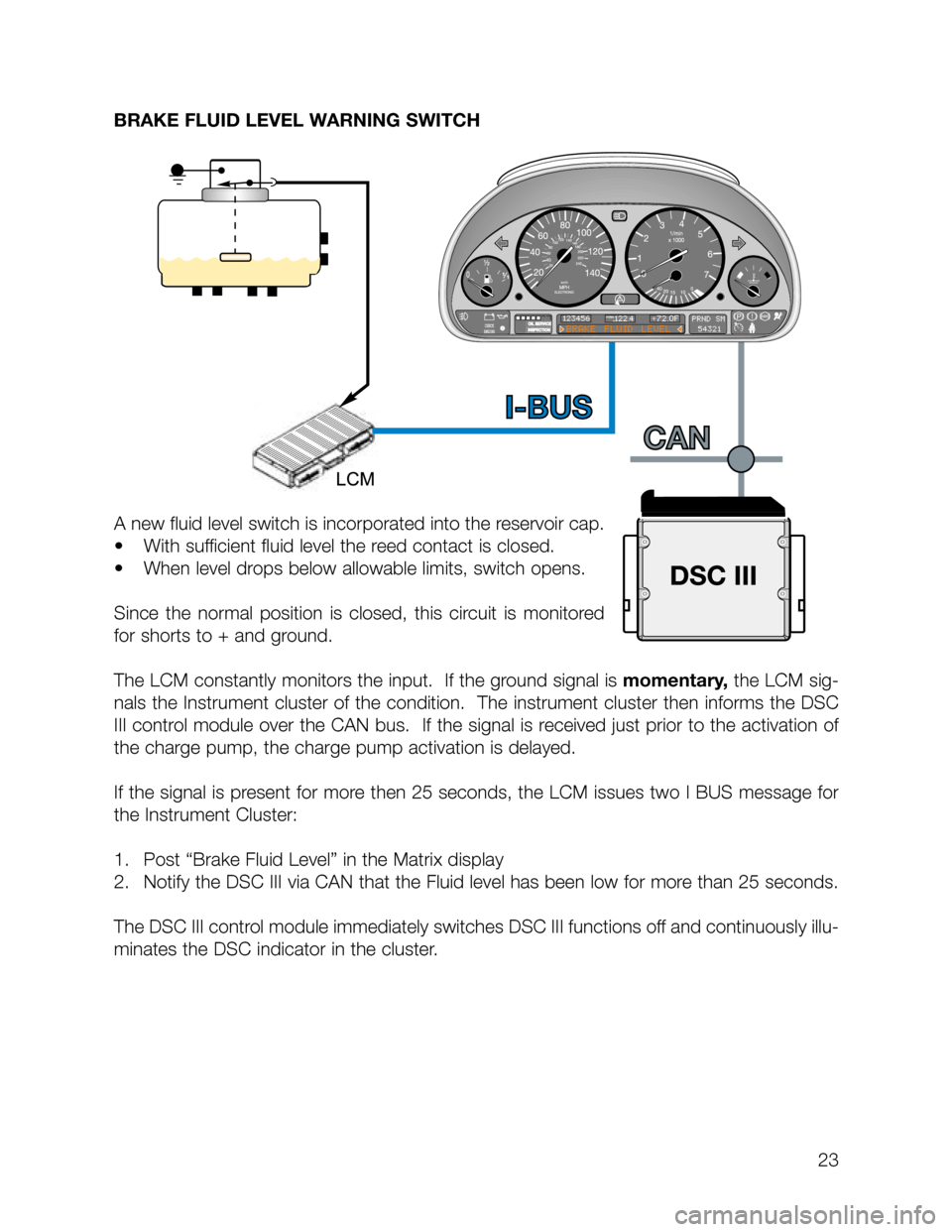Page 17 of 24
Page 18 of 24
18
COMPONENTS
CONTROL MODULE HYDRAULIC UNIT
The control module is integrated into the hydraulic unit as one compact unit. This reduces
the size and wiring required for DSC operation. Additionally the motor relay and valve relay
have been replaced by solid state final stages in the control module. The hydraulic unit con-
tinues to use:
• Two pre-charge solenoid valves
• Two changeover solenoid valves
• Four intake solenoid valves
• Four outlet solenoid valves
• One return pump
Page 19 of 24
19
ROTATION RATE/TRANSVERSE ACCELERATION SENSOR
Located under the center console behind the MRS III control module, the rotation rate and
transverse acceleration sensor provides two inputs to the DSC control module. The sensor
is isolated from body/chassis vibrations through its rubber mounting.
For rotational speed, the sensor produces a reference signal of 2.5 volts and a linear volt-
age signal from 0.7 to 4.3 volts. This linear voltage input signal is used by the DSC control
module as the degree of rotational rate (yaw).
The sensor also produces a linear voltage signal for the lateral acceleration (G-force) that
ranges from 0.5 to 4.5 volts. The DSC control module uses this input to determine the side
forces acting on the vehicle for DSC regulation.
Page 20 of 24
20
BRAKE PRESSURE SENSOR
A brake pressure sensor is installed in the hydraulic unit to determine the degree of pres-
sure build-up for Dynamic Brake Control. It is installed in the front axle brake circuit.
The sensor receives its power supply from the DSC control module and produces a linear
voltage input signal ranging from 0.5 to 4.5 volts depending on how hard the brakes are
applied.
Page 21 of 24

21
DSC III COMPONENTS
HDC SWITCH
The hill decent control function is activated by
pressing the HDC switch located in the center con-
sole. The LED will come on steady when the func-
tion is in standby and flash when HDC is regulating
DSC SWITCH
The system is active whenever the ignition is
switched on. When pressed, the switch provides a
momentary 12 volt signal to the DSC III control
module to switch the system off (DSC indicator in
cluster illuminated.) When pressed again, the sys-
tem switches back on (DSC Indicator in cluster
goes off.)
WHEEL SPEED SENSORS
• 2 wire Hall Effect Sensor - “Square wave generator”.
• 48 pulse incremental wheel incorporated in wheel bear-
ing cover for contaminant protection. 48 pulses = one
complete wheel revolution.
• Stabilized 8 volt power supply to hall element on one
wire, ground path for sensor through second wire back
to control module. Signal is generated by the pulse
wheel affecting voltage flow through hall element creat-
ing a low of .75 and a high of 2.5 volts.
• Sensors identical to DSC II and ASC V systems.
• Sensors provide immediate vehicle speed recognition.
Page 22 of 24

STEERING ANGLE SENSOR
The Steering angle sensor is mounted at the
bottom of the steering spindle (in front of the
flex coupling).
The sensor is equipped with a processor
and is directly linked to the CAN bus to com-
municate with the DSC III module.
The sensor still utilizes two potentiometers to determine the steering angle and the rate of
steering. These are the raw signals the CAN Bus microprocessor utilizes to create the steer-
ing angle signal for broadcast on the CAN bus.
The sensor requires calibration after repairs to the steering or suspension system (found in
DIS Service Functions). Once the calibration is completed the sensor now also sends an
identification number over the CAN bus to the DSC III module. The ID provides confirma-
tion in the DSC module that the steering angle sensor is properly calibrated.
If the ID differs due to component swapping it will not be possible to enter the DSC system
for diagnosis. The DIS will request that the steering angle sensor be recalibrated using the
service functions. Once complete a new ID number is generated and the DSC III control
module and Steering angle sensor are properly mated.
The DSC III logic checks the plausibility of the steering angle sensor against the other DSC
III inputs (front wheel speeds, rotation and lateral acceleration sensors). If battery voltage
is interrupted, the current steering wheel rotation is recalculated by the DSC module eval-
uating the front wheel speeds.
Replacement steering angle sensors must be ZCS coded when installed in the vehicle prior
to the calibration procedure.
22
Page 23 of 24

BRAKE FLUID LEVEL WARNING SWITCH
A new fluid level switch is incorporated into the reservoir cap.
• With sufficient fluid level the reed contact is closed.
• When level drops below allowable limits, switch opens.
Since the normal position is closed, this circuit is monitored
for shorts to + and ground.
The LCM constantly monitors the input. If the ground signal is momentary,the LCM sig-
nals the Instrument cluster of the condition. The instrument cluster then informs the DSC
III control module over the CAN bus. If the signal is received just prior to the activation of
the charge pump, the charge pump activation is delayed.
If the signal is present for more then 25 seconds, the LCM issues two I BUS message for
the Instrument Cluster:
1. Post “Brake Fluid Level” in the Matrix display
2. Notify the DSC III via CAN that the Fluid level has been low for more than 25 seconds.
The DSC III control module immediately switches DSC III functions off and continuously illu-
minates the DSC indicator in the cluster.
23
Page 24 of 24
24
DIAGNOSIS
Diagnosis and troubleshooting of the DSC III system is carried out using the DIS Tester or
MoDiC. The DSC control module performs a self check every time the ignition is switched
on. The warning lamps for DSC and ABS will remain on during the self check.
Any faults with the system will cause the lamps to remain on when the engine is started.
Faults that only effect the DSC operation will cause the DSC warning lamp to remain on,
however ABS can still function.
If the battery has been disconnected, the DSC warning lamp will remain on until the vehi-
cle receives road speed signals front the front wheel speed sensors and the steering angle
sensor can calculate the direction of travel.
Page:
< prev 1-8 9-16 17-24